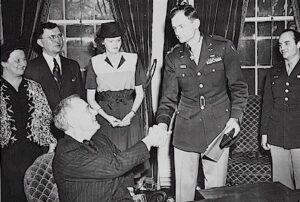Edward Michael
Until The Last Man Comes Home
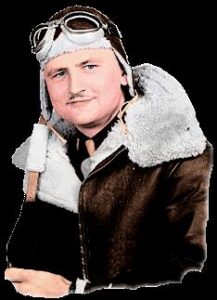
Lieutenant Edward Stanley Michael awakened early and carefully limped his way to the bathroom of his hotel room in the Nation’s Capital. For the most part, the wound to his leg that had confined him to a hospital for seven weeks after a fateful air mission nearly a year earlier had healed, but the tenderness would remain with him for a lifetime.
Outside it was a brisk winter morning on a day many people might have considered to be the biggest day of the young man's life. Within a few hours, the former B-17 pilot would be whisked away to the White House where he would meet his Commander in Chief. At that time, no one could have known it would be the last such ceremony for President Franklin Roosevelt. On this day, Lieutenant Michael was one of six men upon whom President Roosevelt would confer the United States' highest military award, the Medal of Honor.
Glancing at his reflection in the mirror, Lieutenant Michael ran his fingers across the scruffy goatee that adorned his chin, noting how out-of-place the unauthorized facial hair looked next to the crisp brown uniform of a member of the U.S. Army Air Force. Indeed, more than one superior officer had noted the same, and the beard had garnered considerable unfavorable attention. After being released from the hospital, Lieutenant Michael had returned home where an Army general had quickly summoned him to his office to deal with the infraction. "About that mustache and goatee," the general had demanded, "Is that something personal?"
Lieutenant Michael had simply replied, "Yes sir, very personal."
"Big Week," the intensive series of daylight U.S. Army Air Force bombing missions deep into Germany 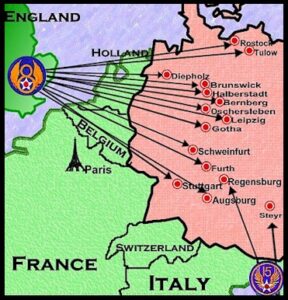 from February 20 - 25, 1944, marked a critical turning point for Allied Forces in the war in Europe. During that last week of February, more than 3,300 American bombers were dispatched from England to strike industrial targets deep inside Germany. The massive aerial armada was supplemented by more than 300 Fifteenth Air Force bombers dispatched from the Mediterranean. The Mighty Eighth alone dropped 8,231 tons of bombs on more than two dozen targets.
from February 20 - 25, 1944, marked a critical turning point for Allied Forces in the war in Europe. During that last week of February, more than 3,300 American bombers were dispatched from England to strike industrial targets deep inside Germany. The massive aerial armada was supplemented by more than 300 Fifteenth Air Force bombers dispatched from the Mediterranean. The Mighty Eighth alone dropped 8,231 tons of bombs on more than two dozen targets.
American losses were heavy - 226 bombers, each with a crew of ten men, and 29 fighters and fighter pilots. "Was it worth it?" Eighth Air Force Commander General Jimmy Doolittle asked rhetorically in his autobiography.
"Initially, I thought it was. We saw immediately that the Luftwaffe did not rise against us in the numbers that it had previously. The U.S. Strategic bombing Survey reported after the war that those operations against the German aircraft industrial system damaged 75 percent of the buildings that produced 90 percent of Germany's aircraft - What hurt the Germans the most was the deterioration in the experience level of their pilots. The Germans lost an estimated 434 pilots during the "big week," out of a total strength of about 2,200.
"Historians tell us that we broke the back of the Luftwaffe that 'big week' of February 1944, and it never again equaled its prior performance."
Indeed, for its high cost in American lives, "Big Week" proved that at last the RAF and USAAF Forces in Europe were within reach of the earliest goals of Allied war planners: Air Superiority
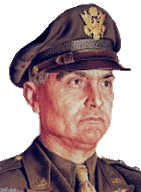 When General Ira Eaker arrived in England early in 1942, the task before he was daunting at best, perhaps even impossible. His newly-formed Eighth Air Force, with but a few bombers and fewer men to fly them, was tasked with attacking an enemy hundreds of miles away in efforts to destroy their ability to make war. Eaker was an enemy well-prepared for war and fielding the most powerful air force in the world. Adolph Hitler's Luftwaffe had been preparing for this battle for more than a decade, and now fielded a cadre of highly-skilled and combat seasoned pilots to prey on Eaker's young and inexperienced crews. In many respects, Germany had learned the hard lessons of combat tactics borne out of World War I, lessons the United States had yet to fully comprehend, and the prospects for an Allied victory in Europe were hanging in the balance.
When General Ira Eaker arrived in England early in 1942, the task before he was daunting at best, perhaps even impossible. His newly-formed Eighth Air Force, with but a few bombers and fewer men to fly them, was tasked with attacking an enemy hundreds of miles away in efforts to destroy their ability to make war. Eaker was an enemy well-prepared for war and fielding the most powerful air force in the world. Adolph Hitler's Luftwaffe had been preparing for this battle for more than a decade, and now fielded a cadre of highly-skilled and combat seasoned pilots to prey on Eaker's young and inexperienced crews. In many respects, Germany had learned the hard lessons of combat tactics borne out of World War I, lessons the United States had yet to fully comprehend, and the prospects for an Allied victory in Europe were hanging in the balance.
That First World War had become a stalemated system of trench warfare--a war of attrition that neither side could win--until United States forces went into action early in 1918. After a successful series of ground, battles to turn back a German ground offensive in the spring, on September 12 the St. Mihiel Offensive threw back the German lines in a 60-day route that led to an armistice on November 11. The great successes on the ground that September was due in no small part to the deployment of an aerial armada, seven hundred fighters, four hundred observation planes, and four hundred bombers, all under the command of General William Billy Mitchell. It was the first massive, strategic deployment of air assets in any war, and airpower proved to be the critical element to victory at St. Mihiel. In the last two months of the war bombing raids over Germany became the crushing blow that brought the war to an end, further establishing the critical role of military aviation.
American airmen returned home as novel heroes, their courage quickly recognized, but their role perhaps under-appreciated. Aviation was still new, and for nearly two decades the World War I veterans of aerial combat found themselves in a struggle to justify their existence as a combat arm. Billy Mitchell's efforts to elevate combat aviation to a leading role in tactical warfare were met with firm resistance among traditional Army leadership, and Naval aviators fared no better.
German aviators faced no such crisis. Despite the fact that the Treaty of Versailles that had ended the First World War forbade Germany from owning and manufacturing military aircraft, military and political leaders of the new Reich recognized the offensive value of the airplane. When Adolph Hitler rose to power in 1934, he made it clear to the world that he had no intention of abiding by the terms of the Treaty of Versailles and began rebuilding the military might of Germany. The following March (1935) Hermann Goering announced the establishment of the new German air force, the Luftwaffe.
A veteran of ground combat in World War I, Adolph Hitler realized the futility of another protracted ground war of attrition. With the insight of Goering, an ace from that war who was credited with shooting down twenty-two Allied airplanes, Germany's strategy for the next war was focused on the air. German military leaders envisioned their next war as a highly mobile, fast-paced theater-level offensive, the kind of warfare most suited to air operations. "Truppenfuhrung", the army operational doctrine manual published in 1934 spelled out this new combat strategy: "In order to successfully carry out major ground operations, one should seek to establish air superiority over the enemy at the decisive point."
Meanwhile in the United States, while Congress debated the value of aircraft as a military asset for appropriations purposes, Germany was building an air force capable of seizing air superiority over all of Europe. Charles Lindberg, the famed American aviator, and world hero was invited to Germany several times in the late 1930s and feted with tours of the building Luftwaffe. Accepting these offers at the behest of the U.S. Military, he returned home with reports on the advanced and powerful air force being built by Goering. While it is obvious Lindberg, as an aviator, was extremely impressed with Germany's foresight in aerial technology, it is equally obvious that he saw in the Luftwaffe a dangerous threat to his own country. On January 7, 1938, he noted in his journal: "I have for a long time believed we should have a stronger Army and Air Force - If we must arm, we should arm for the purpose of our own strength - If England and Germany enter another major war on opposite sides, Western civilization may fall as a result."
Lindberg's accounts of Germany's Luftwaffe, its greatness and advancements, generally became twisted from being an airman's admiration of airpower to an endorsement of the Reich. The man who so often is remembered as a Nazi-sympathizer and anti-Semite, was in fact, neither. On November 13, 1938, he wrote: "My admiration for the Germans is constantly being dashed against some rock such as this. What is the object in this persecution of the Jews." Lindberg admired Germany's dedication to the advancement of airpower, wished in fact that his own country would be similarly forward-thinking. Through it all, he feared that the United States would be drawn into a war where our own unprepared air force would have to face the aerial superiority of Goering's masterpiece. By 1938 Germany was producing 1,100 airplanes a year.
Throughout 1939 and 1940, Hitler unleashed Goering's Luftwaffe across Europe, validating Germany's new strategy for warfare. The overwhelming airpower that was fielded from Berlin quickly subdued Poland, Scandinavia, and the Balkans. During the invasion of Poland alone, Goering committed 1,750 bombers and 1,200 fighters. In 1940 more than 10,000 German airplanes were manufactured to further strengthen this arsenal built for conquest.
In 1940 in but five days, the massive Luftwaffe claimed air superiority in the battle for France, attacking airfields and ending all further resistance from a nation that had proved itself a formidable air opponent in the earlier war. Only in the Battle of Britain were German aviators unable to achieve their goals, a foreshadowing of the difficulties of aerial attack across the English Channel. Before the United States entered the war at the end of 1941, another 11,800 German fighters and bombers had rolled off the assembly lines.
From the moment the United States entered the war in December 1941, Allied planners were myopically focused upon a single strategy to defeat Germany--across (the English) channel land invasion. By the summer of 1942 however, it was obvious that such an invasion would be doomed to failure. Chief among the obstacles was the fact that the Luftwaffe ruled the skies over occupied France, and would quickly cut to pieces any invasion force. The invasion of Northern France was postponed in favor of Operation Torch, the November landings in North Africa. Beyond the rationale of establishing a foothold in the Mediterranean from which to attack Germany's soft underbelly was the more critical need to wrest control of the skies over Northern France from Goering's pilots. That job fell to the British Royal Air Force (R.A.F.) and to Ira Eaker's Eighth Air Force.
By August 17, 1942, General Eaker had enough planes and crews to dispatch twenty-four bombers to attack the railroad marshaling yards at Touen-Sotteville, France. It was a quick in-and-out over enemy-controlled territory, an inauspicious but symbolically important mission. At last, the U.S. Army Air Force had arrived in Europe to challenge Goering's finest and wrest from them aerial superiority. Six months later it was obvious that this would be no easy feat.
In fact, most of the missions flown from August to December in that first year were "hit-and-get" strikes 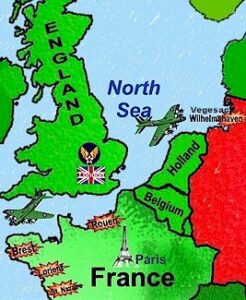 against shoreline targets. German fighter strength over France was powerful and deadly. Meanwhile, industrial plants deep inside Germany and ringing Berlin continued to operate with impunity. More than 15,000 new aircraft were produced by the German war machine in 1942 alone.
against shoreline targets. German fighter strength over France was powerful and deadly. Meanwhile, industrial plants deep inside Germany and ringing Berlin continued to operate with impunity. More than 15,000 new aircraft were produced by the German war machine in 1942 alone.
Making these missions all the more dangerous was the U.S. Air Force's practice of daylight bombardment. The R.A.F. flew most of its missions at night, taking advantage of the darkness to hide their bombers from enemy fighters. The USAAF's doctrine of high altitude, daylight bombardment, was built around the fact that most bomb runs were made visually, and the daylight attacks would improve accuracy over the target. The sturdy B-17 Flying Fortresses and B-24 Liberators were heavily armed and, when flown in strategic formations, could mount a furious defense against enemy fighters.
On short-range missions, U.S. or R.A.F. fighters could escort the big bombers to target in order to engage attacking Luftwaffe fighters. Longer range, unescorted missions, left the big bombers vulnerable, as the R.A.F. had discovered a year earlier - a realization that had prompted them to end daylight bombing for the cover of darkness.
In the first six months, the Eighth Air Force suffered up to seven percent losses on unescorted missions. This gave the daring bomber crews a life expectancy of 14 or 15 missions if all of them were unescorted sorties. Eighth Air Force policy at the time was to establish a 25-mission tour of duty, a goal far too many crews never achieved.
In January 1943 General Eaker left England to meet with Winston Churchill at the Casablanca Conference in North Africa. R.A.F. and some American strategists, concerned with the high rate of American losses, were pushing to abandon daylight bombing. At Casablanca Eaker prevailed upon the British Prime Minister to allow him to continue daylight bombing, a counter-part to the R.A.F.'s night-time sorties. The Combined Bomber Offensive (CBO) thus became an around-the-clock assault on the enemy.
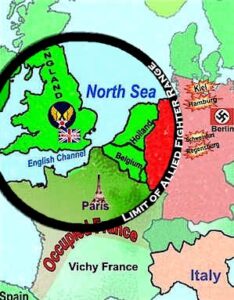 In June 1943 the CBO put into effect Operation Pointblank, a directive to establish target priorities for the various goals desired from the air campaign. Chief on the list of objectives was the destruction of the Luftwaffe in the air, by bombing enemy aircraft on the ground, and in the destruction of the plants that manufactured parts critical to enemy aircraft production. Meanwhile, with American assembly lines rolling off new fighters and bombers in record numbers, the Eighth Air Force grew to the point that by July Eaker could field 300-bomber formations into Northern France and even the fringes of Germany itself.
In June 1943 the CBO put into effect Operation Pointblank, a directive to establish target priorities for the various goals desired from the air campaign. Chief on the list of objectives was the destruction of the Luftwaffe in the air, by bombing enemy aircraft on the ground, and in the destruction of the plants that manufactured parts critical to enemy aircraft production. Meanwhile, with American assembly lines rolling off new fighters and bombers in record numbers, the Eighth Air Force grew to the point that by July Eaker could field 300-bomber formations into Northern France and even the fringes of Germany itself.
By July Eighth Air Force bombers were flying deeper into Germany on unescorted missions well beyond the range of friendly fighters fielded from England. A year of operations had yielded the experience necessary to develop massive formations for mutual protection, but the range of these missions placed the bombers over enemy territory for longer periods and casualties remained high. The influx of new crews and aircraft was all that enabled the Mighty Eighth to continue operations in what had become an aerial war of attrition.
On October 14, 1943, sixteen bomber groups mounted Eighth Air Force mission #115. A total of 291 bombers left bases in England for the long flight deep into Germany to attack the ball-bearing factories at Schweinfurt. The formation was met en route by a swarm of Luftwaffe fighters and only 257 bombers actually entered Germany; only 229 reached and dropped bombs on the target. Sixty B-17s, fully twenty percent of the formation was shot down. Of the 197 bombers that returned to England, five were abandoned or crashed on landing, and seventeen others were so badly damaged they would never fly again.
Black Thursday was a sad dose of reality for the Eighth Air Force. The devastating losses not only threatened the combat effectiveness of the entire organization, but it also emphasized the futility of the valiant efforts expended by Ira Eaker's brave airmen to achieve air superiority over Occupied Europe. It was time to pull back, rebuild, and reassess the mission.
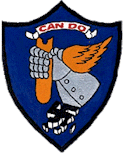 For some bombardment groups rebuilding was more than a priority--it was an absolute necessity. The 305th Bombardment Group had fielded fifteen bombers from three squadrons for the Schweinfurt mission. Theirs was a veteran group, having already served nearly a year of missions with the Eighth Air Force. Despite the hardships, the 305th's aircrews had flown again and again into harm's way, adopting the motto "Can Do." On October 14 the cruelest of fates met fifteen Can Do bombers; only two returned to Chelveston. Of the thirteen bombers and crews, the 305th lost that day, six were from the 364th Bomber Squadron. The 364th's 100% attrition rate and the group's 87% loss rate were the highest suffered by any squadron and/or group of the war. Without new bombers and crews to man them, the Can Do Group's air war looked to be all but over.
For some bombardment groups rebuilding was more than a priority--it was an absolute necessity. The 305th Bombardment Group had fielded fifteen bombers from three squadrons for the Schweinfurt mission. Theirs was a veteran group, having already served nearly a year of missions with the Eighth Air Force. Despite the hardships, the 305th's aircrews had flown again and again into harm's way, adopting the motto "Can Do." On October 14 the cruelest of fates met fifteen Can Do bombers; only two returned to Chelveston. Of the thirteen bombers and crews, the 305th lost that day, six were from the 364th Bomber Squadron. The 364th's 100% attrition rate and the group's 87% loss rate were the highest suffered by any squadron and/or group of the war. Without new bombers and crews to man them, the Can Do Group's air war looked to be all but over.
Lieutenant Edward Stanley Michael
Lieutenant Ed Michael and his crew of nine airmen came to the Can-Do Group's 364th Bombardment Squadron in November. They were one of several crews that arrived at about the same time as badly needed replacements for a squadron that had suffered unbelievable losses in the Schweinfurt mission.
Born in the Windy City on May 2, 1918, Ed would frequently refer to himself jokingly by saying, "I was a mean old kid from Chicago." As a boy growing up, young Ed had been known to his parents by the nickname "Skip." In 1927 at age nine, Skip saw his first airplane flying above the city's rooftops and fell in love. He had always preferred the freedom of the outdoors to the confinement of the city, and the sight of that airplane flying freely among the clouds captivated his young mind. After graduating from Chicago High School in 1936, he purchased private flying lessons and took them to the air.
In November 1940 at age twenty-two, Ed Michael determined to further fulfill his childhood dream of flight and enlisted in the U.S. Army. He applied for Aviation Cadet Training but failed the exam by two points. Within a year he found himself stationed at Wheeler Field in Hawaii as an aircraft mechanic. He was up and about early on the morning of December 7, 1941, not to work on airplanes, but to serve on KP (Kitchen Patrol), when Japanese airplanes attacked Wheeler Field in conjunction with similar attacks at Pearl Harbor and elsewhere across Oahu.
Ed rushed outside in time to see wave after wave of enemy fighters sweeping into riddle-parked American airplanes, and to drop their bombs on nearby hangers. Racing to his duty station he saw another Zero coming towards him and dropping its bombs. Ed raced to an open field and crawled undercover, even as an enemy 27-caliber round hit a rock within three inches of his face, sending fragments into his cheek. It was a superficial wound, one that didn't even earn him a Purple Heart, but Ed Michael was one of the few subsequent pilots of the American Air Force who could claim a combat wound for action on the first day of the war.
With the immediate buildup that followed the Pearl Harbor attack, Ed Michael applied again for Aviation Cadet Training. This time he passed the exam and returned to the mainland for training at Douglas, Arizona. He received his wings and commission on April 12, 1943, and the Army Air Force assigned him a B-17 bomber and a crew of nine men. By November the team was at Chelveston, England, home field for the 305th Can Do Bombardment Group that had been so badly decimated in the Schweinfurt mission a month earlier.
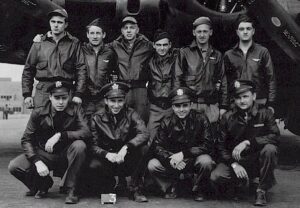
Kneeling (L-R) Westberg, Miller, Lieber, Michael
The three officers, all second lieutenants, that completed Ed Michael's crew were co-pilot Franklin Westberg, Navigator Sid Miller, and Bombardier John Lieber. The six-man enlisted crew included Staff Sergeants Ray Ridge (Flight Engineer), Reynold Evans (Radio Operator), Anthony Russo, and Arthur Kosino (Waist Gunners), with Staff Sergeant Pat Malone in the tail and Staff Sergeant Fred Wilkins suspended below in the Ball Turret. The crew was assigned a B-17 which was promptly christened Bertie Lee after the young lady Ed Michael had met in Arizona while in flight training and subsequently married.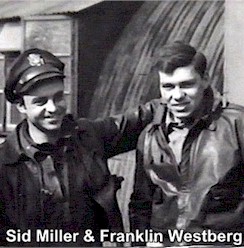
In the weeks after their arrival in England, the members of the bomber crew went various directions for specialized training, but despite such separations, the men remained close. Rank was observed in the Army Air Force, but many formal protocols were ignored as the four officers and six NCOs learned to function as a team. All knew that the fate of them all might well rest in the hands of anyone man among them. Such uncommon familiarity aside, the enlisted men bunked together in barracks reserved for other enlisted crews, and officers bunked together with other officers of the squadron.
One of Ed Michael's bunkmates was another of the newly arrived B-17 pilots sent to bolster the 364th Bombardment Squadron, a friendly country boy named William Lawley of Leeds, Alabama. Ed and Bill became close friends quickly, a friendship they would ultimately share for a lifetime. Within a year both men would find more in common than their friendship, more even than the many responsibilities each shared as commander of a Flying Fortress. Ultimately, the two pilots would experience similar fates over enemy territory that would make the 364th Bombardment Squadron the only USAAF squadron to earn two Medals of Honor for separate actions in the war.
(In three actions in WWII, two men in the same plane would earn Medals of Honor for the same action, but only the 364th would claim two separate actions to merit our Nation's highest military award.)
November 1943 was a relatively slow month for the Eighth Air Force as the squadrons welcomed an infusion of new bombers and crews. Only eight missions, most with fewer than 100 aircraft, were mounted in the first three weeks while these newly arrived airmen underwent training and orientation. On the day after Thanksgiving, November 26, many of these new crews, including the new 305th Bombardment Group aircrews, flew their first mission. A total of 440 bombers flew over the North Sea to attack the port area of Bremen. The Eighth Air Force lost 29 bombers carrying nearly 300 American airmen on that day. The 305th lost five B-17s, two of them from the 364th Bombardment Squadron.
The casualty rate on that day was only 6.5%, far less than what the Mighty Eighth had suffered throughout the summer and fall. Nonetheless, watching one's friends going down in flames over enemy territory was a glimpse of reality that hit home all too quickly. Ray Ridge, Flight Engineer on Ed Michael's Bertie Lee, determined he could take no more. It was a not-uncommon reaction; many men simply could not handle the extreme pressure of air combat. Ridge was busted to Private and assigned to ground duty.
Throughout December the Eighth Air Force mounted more than 5,000 bombers to attack enemy targets, including four repeat missions to Bremen. Fewer than 200 heavy bombers were lost, and only two of those losses were sustained by the rebuilt 305th Bombardment Group. Much of the success of the December missions was justifiably attributed to the arrival of a new, long-range, escort fighter: the P-51 Mustang. Not to be overlooked, however, is the fact that most of these missions were against coastal targets.
As the year wound down to a close, each new mission had provided Ed Michael and his crew with the increased confidence garnered by experience. With each mission, the image of a bomb casing was painted on the fuselage of Bertie Lee as the men counted down to their twenty-fifth mission. If they could make it that far, flight number twenty-six would be the flight back home.
Overlord
The year 1943 closed with a December 30 mission by 650 heavy bombers over the chemical works plant at Ludwigshafen, the deepest penetration of Germany since the October 14 Schweinfurt mission. It signaled a return to the heart of Hitler's industrial complex that was fueling the war, and a renewed effort to halt the production of war material including aircraft. The bomber flight was escorted all the way across occupied France and Belgium by P-51 fighters. Their presence kept American losses at 3%; only 23 bombers and crews were lost.
Meanwhile, the year 1944 had been anticipated since the postponement of the cross-channel invasion two years earlier. With Allied forces battling their way towards Rome in the Mediterranean and with Soviet forces beating back the Nazi forces that had laid siege to the southern outskirts of Leningrad, the D-Day Invasion could be postponed no longer. Both Allied and Axis military leaders knew it was coming and scrambled to marshal their forces either to support or repel, the anticipated Allied attack.
The pressure was mounting on the Mighty Eighth to hasten their effort to claim aerial superiority over Northern France, Belgium, and Holland. Despite his protests at what was presented to him as a promotion, General Ira Eaker was transferred to the Mediterranean to command all Allied air assets in that region. He was replaced in England by General Jimmy Doolittle, who assumed command of the Eighth Air Force with some in trepidation. Ira Eaker was indeed a tough act to follow and Doolittle recalled, "It wouldn't be easy for me to fill his shoes."
Eaker's swan song was a January 5, 400-bomber mission across France and into Germany. Twenty-five bombers were lost, a reminder that enemy fighter strength was still a force to be reckoned with. On that day, the day before Doolittle assumed command, an Eighth Air Force Report noted that "(The) U.S. daylight strategic bombing program against Germany will be threatened unless steps are taken to reduce the enemy's fighter force, which has increased in strength in the West as a result of step-up in production, strengthening of firepower, and transfer of a larger percentage of fighters to Western Front." Doolittle's challenge was thereby clearly dictated.
Doolittle's first mission was a tragic one. After days of poor weather, conditions cleared enough on January 11 to mount a 633-bomber attack deep into Germany. When the weather began to deteriorate over the mainland, Doolittle issued a recall order. All returned but 238 Fortresses, most from the First Air Division. These bombers and their P-51 escorts were confronted by more than 500 German fighters. In the ensuing battle, sixty American bombers went down carrying 600 airmen to their deaths or into captivity. Doolittle's first mission as Eighth Air Force Commander became known as the Second Schweinfurt and put the CBO on notice that the Luftwaffe still had a formidable presence in the region.
Poor weather continued to hinder efforts to strike German factories in the weeks that followed. With Pointblank and its directive of establishing Allied Air Superiority over Western Europe far behind schedule, and with D-Day for Operation Overlord only months away, the pressure was on. The clearing weather in the last week of February that led to "Big Week" provided the necessary turning point.
The 305th Bombardment Group flew multiple missions during "Big Week," losing three bombers on February 20, the opening day. Two of these went down over occupied territory. The third, flown by Ed Michael's friend Lieutenant Bill Lawley, returned to England so badly shot up that it would never fly again. Lawley's heroism and skill in bringing home his battered Cabin in the Sky amazed his comrades and resulted in the Medal of Honor. The empty bunk in Ed Michael's barracks that night was a reminder that one of his close friends, for all his heroism and determination, was in the hospital being treated for severe wounds.
Lieutenant Michael and crew continued to fly throughout that busy week that blanketed Germany with nearly ten thousand tons of bombs. The squadron lost one bomber on February 22, another two days later, and yet another on the last day of the 5-day campaign. Somehow Bertie Lee managed to fly through the flak and enemy fighters on each mission, to return home unscathed. Upon each return, another bomb casing was painted on the fuselage as the men counted down to their last mission.
Indeed, Big Week, if not the turning point of the air war, proved that continued massive bombing missions could cut back on Germany's ability to turn out more aircraft. Furthermore, as the American bombers moved ever closer to Berlin, they drew more and more enemy fighters into the air where P-51 fighter pilots could shoot them out of the sky. General Adolf Galland, head of the Luftwaffe fighter force, later estimated that 1,000 German pilots were shot down from January to April of 1944. Most of these were experienced pilots, which were replaced by less-experienced Axis airmen, who then became fodder for the American fighters that escorted the bombers into harm's way.
Wrote Doolittle,
"It is generally conceded that the war in the air against Germany was won during the phase of our operations between the beginning of February 1944 and D-Day. The rate of attrition of the Luftwaffe's pilots exceeded Germany's rate of replacement. Also, several months of reduced aircraft production during a crucial period created a temporary shortage of reserve aircraft that was difficult to overcome. Thus, Germany was low in two essentials at a critical point: aircraft and pilots."
On March 4 General Doolittle dispatched his bombers to attack Berlin. The German capital and headquarters of Adolph Hitler had been subjected to night bombing by the R.A.F. for years but never before had American forces appeared over the city in broad daylight. Deteriorating weather foiled the effort, however, and it was not until two days later that a 660-bomber force, escorted by P-51s, appeared defiantly over Hitler's fortress. Jimmy Doolittle had begged to lead that mission. He had been first over Tokyo in the 1942 raid that made him famous. As commander of the 12th Air Force in the Mediterranean, on July 19, 1943, Doolittle had led the first bombing raid on Rome. His hope to lead the first American bombing raid on Berlin would have made him the only man to be the first overall three major Axis capitols. Doolittle was sorely disappointed when his request was denied but tried to understand the reasoning. With his knowledge of the D-Day invasion plan that was now only two months away, Allied Command could not risk the possibility of General Doolittle being shot down and captured.
Lieutenant Ed Michael was not privy to such knowledge, and as such, was scheduled to fly that day. It was a mission that Bertie Lee wing gunner Arthur Kosino would never forget. On a day in which 69 American bombers and 11 American fighter planes went down, Art and his comrades in Bertie Lee returned safely home. What more could a young man ask for on his twenty-first birthday?
The improving Spring weather made it possible for the Mighty Eighth to mount near-daily missions to attack targets from Paris to Berlin, and beyond. Ed Michael and crew at one point flew six missions in seven days. By early March the images of seventeen bomb casings adorned the nose of the big bomber, and the crew began to realize that indeed, they might achieve that elusive twenty-fifth and final mission.
Despite continued and determined fighter resistance to the unrelenting pounding unleashed by the Mighty Eighth from February to April, fewer and fewer bombers were falling from the skies. Not only was the Luftwaffe reeling from its own heavy losses, but General Doolittle's keen tactical abilities in the deployment of his fighters were also improving the chances of his bomber crews returning safely home.
The new commander of the Eighth Air Force gained the respect and admiration of his fighter pilots when he unleashed them to go on the offensive. Previously fighters had been used as defensive weapons, as escorts to protect an inbound bomber formation from outside attack. Doolittle allowed his fighters to break away from the bomber stream in order to take the fight to the enemy before they reached the formation.
Doolittle further ingratiated himself to the bomber pilots by introducing a staggered system of fighter deployment that made possible an escort all the way to target and back. A P-51 escorting a slow-moving heavy bomber formation from England burned fuel at a rate that limited range. So Doolittle staggered his fighter assets in a fuel-efficient relay system. R.A.F. Spitfires, with limited range, escorted the formation across the English Channel or the North Sea for about 100 miles. There American P-47 Thunderbolts rendezvoused to escort the formation for the next 150 to 200 miles. When the Thunderbolts turned back, P-38 Lightnings with droppable wing tanks took over for the final leg, thereby providing inbound escort for 450 or more miles. Meanwhile, the late-takeoff P-51 Mustangs raced in to accept the baton and escort the formation to target and back to the 450-mile range where refueled Lightnings waited to begin the reverse process all the way home.
Doolittle's pilots and crews worked the impossible from February until D-Day, effectively dismantling the Luftwaffe in the air, on the ground, and in the production facilities. Further, in anticipation of the coming invasion, the bombers and fighters repeatedly attacked and destroyed critical rail lines, supply depots, and other strategic targets. Then Doolittle reassessed the 25-mission policy and determined it too, needed revision. With the chances of survival improving for aircrews, and in the belief that the 25-mission limit was sending experienced aircrews home prematurely, he extended the tour of duty to 30 missions. (Later in the year it was increased to 35.) Needless to say, it was perhaps, the general's most unpopular action.
For crews like Lieutenant Michael's that had already flown many missions, a pro-rate was established. With seventeen missions, under this system, the crew of Bertie Lee would only be required to fulfill twenty-seven. Newly arrived crews, however, would be expected to fulfill the full thirty before being sent home - that is if they survived. With all the new success of the Allied air war in Europe, the Luftwaffe was still unbeaten and remained a formidable adversary.
Early in April Ed Michael and crew flew their twenty-fifth mission. Instead of mission twenty-six being the flight home, it was now an April 11 mission to bomb a ball-bearing factory at Stettin, 75 miles on the other side of Berlin.
Command Decision
As Lieutenant Michael warmed his engines for the morning take-off, seven of the crew aboard Bertie Lee were members of the original crew and were now flying their 26th mission, the second-to-last. Lieutenant M. M. Calvert had introduced himself that morning as the mission's navigator, replacing Sid Miller on this flight. "Calvert," he had told Michael, "like the whiskey!" He further advised the pilot that this would be his first mission. Such a shifting of crews was not uncommon, especially among the veteran bomber crews. Recently arrived replacements were frequently shuffled into a mission to fly their first bombing run among a crew that had been there many times before.
Staff Sergeant Clarence Luce was another first-timer, replacing Pat Malone in the tail. Staff Sergeant Jewell Phillips, also flying his first mission, was assigned as Flight Engineer. His position during the flight was the Top Turret once occupied by Ray Ridge, and then by a succession of replacements when Ray opted out for ground duty.
Bertie Lee lifted off from Chelveston shortly after 6:30 am for what promised to be a long flight. Michael would fly in the last element of the bomber stream, carrying forty-two 100-pound incendiary bombs to set fire to anything not demolished by the bombs other Fortresses and Liberators were carrying ahead of him. It promised to be a long day and Michael later recalled being given the traditional Mars Bar to eat on the way home "for energy." Like most airmen, he ate his right away. There was no promise that he would have a latter opportunity to do so, no assurance that he would ever again be coming home.
Four hours out of Chelveston and deep into enemy territory, the first dark puffs of deadly flak began to fill the sky. One shell exploded nearby, ripping a large hole in Bertie Lee's right-wing.
At the waist, Art Kosino and Anthony Russo stood at the ready, waiting for the fighters they knew would be coming soon. In the distance a group of Messerschmitts tore into a flight of B-24 Liberators, wreaking havoc and sending thirteen of the bombers down in flames. Amid bursting flak, flashing tracers, smoke, fire, and an occasional parachute, the formation pressed on towards the target.
Thirty miles south of Berlin and approaching their IP (Initial Point-where the bombers would line up on  their run to target), the B-17 formation was confronted by more than 100 Messerschmitts and Focke-Wulfs. The enemy fighters were massed for a full, frontal attack from eleven o'clock high. "I'd seen action before," Michael later recalled, "but this was the worst." With abandon the Luftwaffe pilots swooped through the formation, wreaking havoc and doing their best to break up the integrity of the close-order formation.
their run to target), the B-17 formation was confronted by more than 100 Messerschmitts and Focke-Wulfs. The enemy fighters were massed for a full, frontal attack from eleven o'clock high. "I'd seen action before," Michael later recalled, "but this was the worst." With abandon the Luftwaffe pilots swooped through the formation, wreaking havoc and doing their best to break up the integrity of the close-order formation.
Ahead of Bertie Lee one flaming Fortress pummeled earthward, while another broke formation to limp off towards Sweden. And then the enemy fighters were sweeping in on Bertie Lee, raking her skin with 20-mm cannon while Michael's gunners returned fire in all directions. Two engines took direct hits causing major damage, while more rounds raked the Top Turret. Other rounds raked the fuselage, shredding the radio room along with the parachute Sergeant Reynold Evans normally stored on top of his equipment.
Worst of all was the fusillade that slammed into the cockpit, striking the pilot in the thigh and 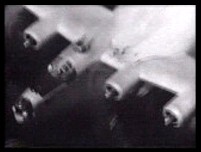 destroying most of the instruments. A continuing hail of flaming cannon fire tore through the controls sending Bertie Lee into convulsions, wounding the co-pilot, and blowing out a side window. Hydraulic fluid coated the windshield and smoke filled the cabin as the heavily laden Fortress bucked and slewed under the devastating fire. In seconds Bertie Lee began falling quickly in a fatal spin as the wounded pilot and Lieutenant Westberg fought for control. "It took our combined strength and energy to get her straight and level again," the co-pilot recalled. "We lost about 3,000 feet--but not the fighters."
destroying most of the instruments. A continuing hail of flaming cannon fire tore through the controls sending Bertie Lee into convulsions, wounding the co-pilot, and blowing out a side window. Hydraulic fluid coated the windshield and smoke filled the cabin as the heavily laden Fortress bucked and slewed under the devastating fire. In seconds Bertie Lee began falling quickly in a fatal spin as the wounded pilot and Lieutenant Westberg fought for control. "It took our combined strength and energy to get her straight and level again," the co-pilot recalled. "We lost about 3,000 feet--but not the fighters."
Alone now and out of formation, the wounded Bertie Lee was at her most vulnerable, and the enemy fighters took advantage of the situation. 20-mm rounds raked the airship from nose to tail while Lieutenant Michael, heedless of the flow of blood from his badly wounded thigh, fought to keep his bomber airborne. The vibrations pitched the men below about like leaves in the wind, while tracers streaked through metal to pass by them dangerously close to vital organs. Somehow Reynold Evans managed to make his way to the cockpit to shout, "The bomb bay is on fire." Enemy gunfire had ignited at least three of the 100 incendiary bombs, and Michael knew he had only seconds before a massive explosion would tear them all apart. He hit the emergency switch for the bomb bay doors, but nothing happened. Bertie Lee could not disgorge her deadly and now burning cargo.
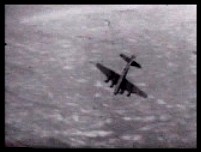 "Everybody out," Lieutenant Michael shouted into his microphone. "We've got a fire in the bomb bay. Everybody out before it reaches the fuel tanks... Bail Out! Bail Out! Bail Out!"
"Everybody out," Lieutenant Michael shouted into his microphone. "We've got a fire in the bomb bay. Everybody out before it reaches the fuel tanks... Bail Out! Bail Out! Bail Out!"
In the tail, Clarence Luce opened the hatch and leaped for safety, while further forward Lieutenant Calvert buckled on his own parachute and leaped from the flaming bomber. For both men, it was a heck of a way to spend their first--and ultimately their last, combat mission. At the waist, Anthony Russo emerged from the Ball Turret to make his own escape, while Fred Wilkins and Art Kosino snapped their own chutes into the harness. Suddenly Reynold Evans appeared, ashen-faced to cry out, "Don't leave me!"
Evans parachute had been shredded beyond use by the rounds that had ripped apart the radio room. Hastily he and Art began working at their respective harnesses, attempting to devise a means by which the latter could attach Evans to his own chute. "We were going to try to ride down together on my chute,"  Art recalled in a recent interview. "Then we found a stored duffel bag with an extra parachute in it. I helped Reynold snap it in place and we went out the door."
Art recalled in a recent interview. "Then we found a stored duffel bag with an extra parachute in it. I helped Reynold snap it in place and we went out the door."
Six chutes were floating earthward as Lieutenant Michael and his co-pilot prepared for their own exit. Before they could leave the cockpit, enemy fighters hit again and Michael remained at the controls long enough to seek shelter in some sparse cloud cover. Suddenly Michael noticed Jewell Phillips staggering toward him on the catwalk. The socket above his cheek was empty, and Sergeant Phillips held what was left of his eye in his one good hand. The other arm was shattered by enemy fire, leaving him incapable of properly attaching the chute or even pulling the ripcord.
Quickly Lieutenant Michael snapped the parachute into place, stood Phillips in the doorway, pulled the ripcord, and pushed him into the wind. The bombs had been burning for twenty minutes and, though amazingly there had been no explosion, both men knew it might come at any moment. The time had finally come for the pilot and co-pilot to make their own last-chance exit. Then the two men heard machinegun fire rattling from the bomber's shattered Plexiglas nose. Moving forward leaving a trail of his own blood that streamed down his leg, Michael found Lieutenant Lieber still fending off enemy fighters. The bombardier had not heard the "Bail Out" order.
"My God, Lieb, get your chute on and get the hell out of here," Michael yelled above the roar of wind through the shattered nose. "The bomb bay is on fire and this ship is going to blow any minute."
Lieutenant Lieber turned and picked up the pack that had once held the soft silk of his own parachute. It was riddled with bullets and shrapnel; it was totally worthless. "Here, take mine," Michael ordered as he began unsnapping his own chute from the harness.
"I'm not taking anybody's chute," Lieber replied and he turned back to his guns.
Michael immediately realized further argument would
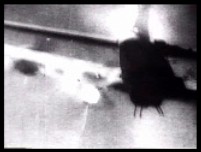
be futile. "Then get the hell back to the bomb bay and see what you can do to get rid of that load," he shouted as he staggered back to the cockpit. Frank Westberg had been struggling to hold Bertie Lee steady while Michael went below, and was prepared to jump immediately behind his aircraft commander. Lieutenant Michael later recounted what happened when he settled back in the pilot's seat: "I looked at Wes, and he looked at me, and I tell ya', he must have had the scariest look on his face. I must have had it on mine too, the way he looked at me. 'Lieb's down there...his chute's no good,' I said."
"Give him mine!" Westberg shouted back.
"He won't take mine, he won't take yours...he says he's not taking anybody’s chute," Michael announced 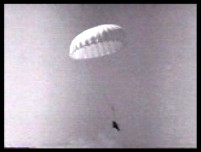 as he resumed his place at the controls. With three men remaining in the badly burning bomber, and only two good parachutes, Ed Michael was out of options. The only hope now was to escape from the fighters that had hammered Bertie Lee for nearly forty-five minutes and try to put the airplane down somewhere in France. Michael dove for the deck as he felt the bomber suddenly lighten. John Lieber had managed somehow to get the bomb bay doors open and eject the bomb load. Michael fought off the dizziness that swept over him, both from loss of blood and the rapid descent, to bring his bomber to tree-top level. The leg of his flight suit was soaked in blood, with a pool of crimson around his feet when Lieber entered the cockpit. When Michael leveled off at barely more than fifty feet above the ground, Westberg took the controls while the bombardier tried to apply first aid to his wounded pilot, and stem the increasing flow of blood.
as he resumed his place at the controls. With three men remaining in the badly burning bomber, and only two good parachutes, Ed Michael was out of options. The only hope now was to escape from the fighters that had hammered Bertie Lee for nearly forty-five minutes and try to put the airplane down somewhere in France. Michael dove for the deck as he felt the bomber suddenly lighten. John Lieber had managed somehow to get the bomb bay doors open and eject the bomb load. Michael fought off the dizziness that swept over him, both from loss of blood and the rapid descent, to bring his bomber to tree-top level. The leg of his flight suit was soaked in blood, with a pool of crimson around his feet when Lieber entered the cockpit. When Michael leveled off at barely more than fifty feet above the ground, Westberg took the controls while the bombardier tried to apply first aid to his wounded pilot, and stem the increasing flow of blood.
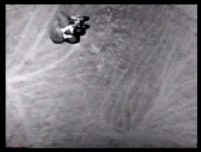 The dive to the ground had shaken off the fighters, but plenty of danger remained. In one of the enemy fighters' last passes, the windshield had been shot out, eliminating all forward visibility in the cockpit. With two engines gone, the instruments shattered, the control cables shot out, and damage to the right-wing, it was a miracle that Bertie Lee was still airborne. The ball turret hung paralyzed with its guns in a downward position and the bomb bay doors refused to close, adding more drag to the already sluggish airplane. Ground fire knocked out the rudder and damaged the elevators. To make matters worse, the fire in the bomb bay had burned a gaping hole in the fuselage that made it likely the big Flying Fortress might split in two at any moment.
The dive to the ground had shaken off the fighters, but plenty of danger remained. In one of the enemy fighters' last passes, the windshield had been shot out, eliminating all forward visibility in the cockpit. With two engines gone, the instruments shattered, the control cables shot out, and damage to the right-wing, it was a miracle that Bertie Lee was still airborne. The ball turret hung paralyzed with its guns in a downward position and the bomb bay doors refused to close, adding more drag to the already sluggish airplane. Ground fire knocked out the rudder and damaged the elevators. To make matters worse, the fire in the bomb bay had burned a gaping hole in the fuselage that made it likely the big Flying Fortress might split in two at any moment.
Because of the extreme loss of blood from the wound in his thigh, Lieutenant Michael began to pass in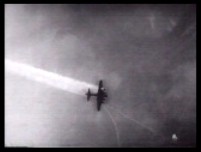 and out of consciousness more and more frequently. Lieber would patch him up and pull him back from the controls so Westberg could take over until the pilot, disoriented and fighting off dizziness, came back around. Over Holland, Bertie Lee was so low that the men in the cockpit could look out the side windows to see friendly farmers waving their hats and pointing the way to England.
and out of consciousness more and more frequently. Lieber would patch him up and pull him back from the controls so Westberg could take over until the pilot, disoriented and fighting off dizziness, came back around. Over Holland, Bertie Lee was so low that the men in the cockpit could look out the side windows to see friendly farmers waving their hats and pointing the way to England.
Lieutenant Michael passed out as the bomber left the coast and headed out over the North Sea. Westberg fought the controls while Lieber tended to Michael until at last the coast of England came into view. Lieber pointed out the airfield at Grimsby and Westberg began to circle while the bombardier fired flares since the radio was out. The landing would be as dangerous as the trek home. Bertie Lee had no undercarriage, no flaps or rudder, no airspeed indicator, or altimeter. Westberg tried to rouse his hemorrhaging pilot to ask if a landing was even possible under such conditions. Lieutenant Michael managed to force himself back to consciousness at this critical moment. While Westberg circled, Michael ordered the two men to take the bomber's two remaining good parachutes and jump. Having 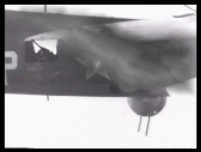 forced his body under control now, he would risk the landing alone. Both men refused--they had come this far together and whatever fate the impending landing might hold, they would face that together.
forced his body under control now, he would risk the landing alone. Both men refused--they had come this far together and whatever fate the impending landing might hold, they would face that together.
Ed Michael fought off his pain and dizziness and steeled himself to the task at hand. With the bomb bay doors still open and the ball turret guns stuck downward, it would be a nearly impossible task to put his Fortress on the ground without killing all aboard. With the structural integrity of the fuselage destroyed by the gaping hole burned in the bomb bay, in all likelihood the stress of hitting the solid ground would break the ship in two.
Bertie Lee leveled out as she droned earthward at more than 100 miles per hour. Michael struggled 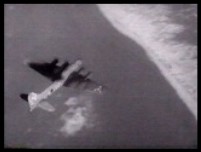 against the controls, deftly doing the impossible. R.A.F. pilots at Grimsby later proclaimed it the most perfect crash landing they had ever witnessed. All three men aboard were alive, though Michael and Westberg were met by ambulances and rushed to a hospital. Bertie Lee would never fly again; mission twenty-six had pummeled her beyond repair - even beyond salvage for parts.
against the controls, deftly doing the impossible. R.A.F. pilots at Grimsby later proclaimed it the most perfect crash landing they had ever witnessed. All three men aboard were alive, though Michael and Westberg were met by ambulances and rushed to a hospital. Bertie Lee would never fly again; mission twenty-six had pummeled her beyond repair - even beyond salvage for parts.
Lieutenant Michael was severely wounded, and it was only after a few days and several transfusions that the revitalized flow of blood to his brain began to clear the cobwebs. As he began to think more clearly, one of his first concerns was for his parents. If not already, they would shortly learn that their son had been wounded in combat. The telegram would be brief, succinct, and devoid of details to answer the myriad of questions that would haunt them. Six days after that fateful mission Ed Michael began penning a letter home.
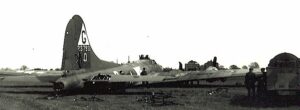
He knew that mail was censured, much more so with the D-Day offensive only weeks away. So he 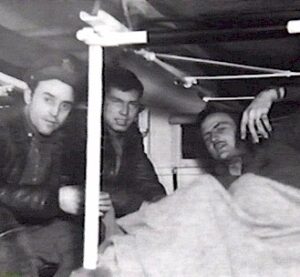 penned a brief letter recounting a mission flown by another pilot, a twenty-sixth mission in which that pilot was wounded, seven men ordered to bail out, and the crippled plane somehow brought back home. He identified the other pilots as "Skip," knowing his parents would recall his childhood nickname and understand that their son was describing his own ordeal. The letter would get past the censors, and ultimately his parents would understand that "Skip"--Lieutenant Edward Stanley Michael, was okay.
penned a brief letter recounting a mission flown by another pilot, a twenty-sixth mission in which that pilot was wounded, seven men ordered to bail out, and the crippled plane somehow brought back home. He identified the other pilots as "Skip," knowing his parents would recall his childhood nickname and understand that their son was describing his own ordeal. The letter would get past the censors, and ultimately his parents would understand that "Skip"--Lieutenant Edward Stanley Michael, was okay.
Dear Mom & Dad
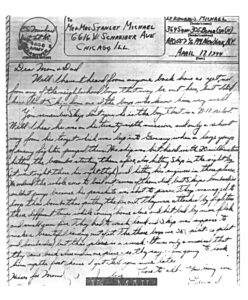
Well I haven't heard from anyone back home as yet nor from any of the neighborhood boys that may be out here but I did hear about Skip from one of the boys who knows him very well. You remember Skip don't you? He is the boy that is a B-17 pilot. Well, I hear that he was on his twenty-sixth mission and only a short way from his target which was deep into Germany when a large group of enemy fighters jumped them. His ship was hit hard with 20 millimeters hitting the bombs starting them afire, also hitting Skip in the right leg (it went right through his left thigh) and hitting his engines in several places. He ordered the whole crew to bail out, seven of them did, but Ship's bombardier couldn't jump because his parachute was hot to pieces. They managed to get to drop their bombs thus putting the fire out. They were attacked by fighters three different times while coming home alone and hit bad by more flak and small gunfire. They had to crash land and Skip was able to make a beautiful landing out of it. The three boys were Skip (pilot-copilot and bombardier) but the plane was a wreck. It was only a miracle that they came back alive and in one piece - so they say. I am going to look him up the first chance I get - tell you more later.
Kisses to Mom. I love you all.
Edward
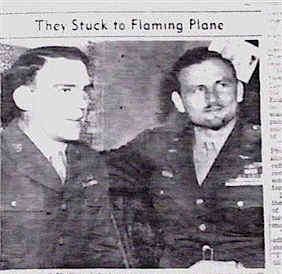 During the seven weeks, Lieutenant Michael was in the hospital, Westberg and Lieberman returned several times to visit with their heroic skipper. It was a difficult period for Lieutenant Michael, lying helpless in bed, unable to do more than think back on the April 11 mission and all that had happened. He had become something of a hero in the 305th Bombardment Group, the pilot who had accomplished the impossible by bringing home his battered bomber to save the lives of two of his men. To Michael the praise meant little--seven of his men had been lost.
During the seven weeks, Lieutenant Michael was in the hospital, Westberg and Lieberman returned several times to visit with their heroic skipper. It was a difficult period for Lieutenant Michael, lying helpless in bed, unable to do more than think back on the April 11 mission and all that had happened. He had become something of a hero in the 305th Bombardment Group, the pilot who had accomplished the impossible by bringing home his battered bomber to save the lives of two of his men. To Michael the praise meant little--seven of his men had been lost.
Those seven men haunted Michael in his dreams and filled his mind with questions when he was awake. Beyond the question of where those seven men were now was Ed's guilt at giving the "bailout" order. Lieutenant Michael had been their commander, the leader of their team that they had all respected and looked up to. They had trusted him time and again to bring them safely home, yet on April 11 he had ordered them to jump from a bomber he had ultimately managed to nurse back to safety.
It was an irrational rebuke, and any seasoned pilot would quickly tell Michael he had done the right thing--the only thing to be done under the circumstances. Even the kind words and friendly admonitions of Westberg and Lieber could not assuage Lieutenant Michael's self-recrimination and anguish.
During that first week in the hospital, saving Ed Michael's life had taken precedence over personal 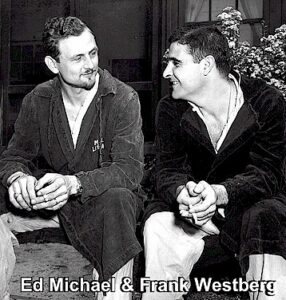 appearance. Now, as the pilot pondered the fate of his seven crewmen, he reached up to scratch the stubble that had appeared on his chin. At that moment he made a promise, a promise to himself and seven men on the ground somewhere in Germany. Lieutenant Ed Michael would not shave until he had learned the fate of each of the seven that had been left behind.
appearance. Now, as the pilot pondered the fate of his seven crewmen, he reached up to scratch the stubble that had appeared on his chin. At that moment he made a promise, a promise to himself and seven men on the ground somewhere in Germany. Lieutenant Ed Michael would not shave until he had learned the fate of each of the seven that had been left behind.
By early July Lieutenant Michael was back in the United States and returning to limited Army Air Force Duty. His heroism on that twenty-sixth mission had resulted in a nomination for the Medal of Honor, a fact that could not be overlooked despite the unauthorized mustache and goatee he continued to wear. When confronted by one general and asked if the facial hair was "something personal," Lieutenant Michael simply replied, "Yes sir, VERY personal."
As the summer wore on, news trickled in about the fate of six of the seven missing men. All had survived and were being held as Prisoners of War. Still, Lieutenant Michael refused to shave. He would keep his promise; he would abide by the vow made to himself, and silently uttered to seven men far away.
Lieutenant Ed Michael would not break that vow until the last man came home!
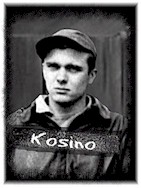 Bertie Lee had disappeared from the sky by the time Arthur Kosino hit the ground. The young sergeant had no way of knowing who had got out, and who had gone down with the plane, nor did he have time to contemplate such matters. Touching down near Helmstadt, Germany, he was unarmed and alone in a foreign and hostile land and confronted by a local citizen wielding a shotgun. Minutes later he was marched through the nearby town while residents yelled "luftgangster" over and over again, spitting and kicking at his vulnerable body.
Bertie Lee had disappeared from the sky by the time Arthur Kosino hit the ground. The young sergeant had no way of knowing who had got out, and who had gone down with the plane, nor did he have time to contemplate such matters. Touching down near Helmstadt, Germany, he was unarmed and alone in a foreign and hostile land and confronted by a local citizen wielding a shotgun. Minutes later he was marched through the nearby town while residents yelled "luftgangster" over and over again, spitting and kicking at his vulnerable body.
He was then turned over to the Gestapo, two fierce-looking soldiers who placed him in the sidecar of a motorcycle. While one drove, the other sat in the side-car behind the frightened airman, a machinegun pressed into his back. The motorcycle stopped at a makeshift prison where Art was put into solitary confinement. Huddling in the darkness, he could hear the sounds of a firing squad outside and wondered if he would be next.
After three days in solitary confinement, Art was taken out for interrogation, and then placed in a crowded, windowless boxcar and transported with other prisoners to Frankfurt. At the Frankfort station, where they captured Americans were to board a civilian train to their final destination, they were surrounded by a gang of 12 to 14-year-old boys, all of them armed with pistols and sabers. These were Hitler's "Brown Shirts," impressionable young men who had become indoctrinated with the Nazi hatred of others and pressed into service. Heady with authority, the young boys spit on the prisoners and taunted them loudly, trying to push them into making a serious mistake. Art, and the other prisoners, swallowed what little pride remained and stood silently waiting for their train.
Art's final destination was Stalag 17-B near Krems, Austria. The barbed wire encampment, surrounded  by German gun towers, became home to nearly 5,000 American NCOs, generally, the crews of bombers shot down over occupied territory. Shortly after arriving Art began finding other members of the Bertie Lee crew. Reynold Evans, Fred Wilkins, Anthony Russo, and Clarence Luce reunited with Kasino, and from that point on the five men stuck together until repatriation. The men had no idea of the fate of the officers from their crew; officers were held in a separate camp. They hoped and prayed, however, that eventually the last enlisted man who had been with them for their final mission, Staff Sergeant Jewell Phillips, would eventually join them.
by German gun towers, became home to nearly 5,000 American NCOs, generally, the crews of bombers shot down over occupied territory. Shortly after arriving Art began finding other members of the Bertie Lee crew. Reynold Evans, Fred Wilkins, Anthony Russo, and Clarence Luce reunited with Kasino, and from that point on the five men stuck together until repatriation. The men had no idea of the fate of the officers from their crew; officers were held in a separate camp. They hoped and prayed, however, that eventually the last enlisted man who had been with them for their final mission, Staff Sergeant Jewell Phillips, would eventually join them.
It was not to be.
Life was difficult at Stalag 17-B; Oberst Kuhn, the camp commandant, tended to be both ruthless and unreasonable. Nonetheless, the men did have access to Red Cross parcels and the Red Cross had information as to the identity of most men held there. In fact, many times it was Red Cross parcels that kept the men alive, a single parcel being shared among three men.
The prisoners lived in tar paper shacks, where bunks were stacked three-high and covered with rudimentary mattresses, canvas bags filled with wood chips. Each prisoner was allowed one blanket, small comfort throughout the winter of 1944-45, which was unusually cold and snowy. During many of the sub-zero days and nights, the prisoners pilfered boards from the latrines, or anywhere else they could find it, to burn for heat. Had they been caught they would have been severely punished. Without that fuel for the stoves, they might well have frozen to death.
Art and his four crewmates spent more than a year in captivity. By April 8, 1945, the war in Europe was 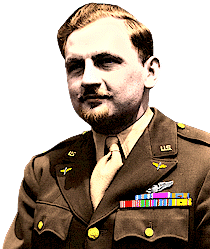 almost over and the Allies were driving towards Krems. On that day, the NCOs of Bertie Lee, minus the still-missing Staff Sergeant Phillips, were among 4,000 American POWs sent on a forced march out of Stalag 17-B. (Nine hundred men were left behind, all too ill to make the march.
almost over and the Allies were driving towards Krems. On that day, the NCOs of Bertie Lee, minus the still-missing Staff Sergeant Phillips, were among 4,000 American POWs sent on a forced march out of Stalag 17-B. (Nine hundred men were left behind, all too ill to make the march.
The column was divided into eight groups of 500 men, each guarded by about 20 Germans with two dogs. Art and his four comrades managed to remain together throughout the march to Braunau, Austria, 281 miles away. Before leaving the prisoners departed, each was given Red Cross parcels containing provisions for seven days. Ultimately, the march took eighteen days, and when supplies ran out the prisoners were left to fend for themselves. Only once did the Germans provide food, one loaf of bread to be shared by 17 men. To make matters worse, the bread was filled with wood chips.
The prisoners were forced to sleep in open fields during their sojourn, except for three nights when their route took them through nearby farms, where they found shelter in barns and out-buildings. One of Art's comrades managed to steal a chicken, which he killed and hid under his coat until the five friends could get an old grease can to fill with water and boil their only hot meal.
By the end of the month, the prisoners reached Braunau, where an improvised camp was constructed in an open field, the POWs using jackknives to cut down small trees from the nearby forest for shelter. The following day each man received a Red Cross parcel, with a second issue two days later, this time one parcel for every fifth man.
On May 3, six soldiers of George Patton's 13th Armored Division drove into the camp in three Jeeps and easily captured the 205 remaining German guards. Other elements of Patton's division followed, and on May 9, the day after Germany surrendered, Art Kasino, Reynold Evans, Fred Wilkins, Anthony Russo, and Clarence Luce were flown by C-47 to Camp Lucky Strike in France, for the first leg of their trip back home.
The five returning men who had flown into enemy territory a year before still knew nothing of the fate of their missing comrades. Indeed, they didn't even know that four months earlier their pilot had been presented the Medal of Honor for somehow getting Bertie Lee back to England.
January 10, 1945
Lieutenant Michael considered his reflection in the mirror of the bathroom of his Washington, DC, hotel room and ran the comb through his hair one more time to ensure that everything was in place. Glancing again at the stubble of hair at his chin, he reflected on the nine months that had passed since the mission that today would earn him the Medal of Honor. Though at the moment he could only imagine the difficulties six of his men were undergoing in the cold winter that was being reported in Europe, he at least knew those men were alive. In the previous months, the Red Cross had announced the status of five of Michael's NCOs at Stalag 17-B, as well as the fact that Lieutenant Calvert had also been captured and was being held in a separate camp for Air Force officers.
Ed brushed the lint from the lapel of his otherwise immaculate uniform, and then again fingered the goatee that looked so out-of-place on his chin. Something personal? Very personal indeed. Somewhere, he hoped, Jewell Phillips was still alive. There had been pressure certainly, to bring his appearance into conformity with Army regulations; more so when he was put on notice to head for Washington, DC. It was an incredible thing to be decorated with the Medal of Honor, and an awesome privilege to meet President Franklin D. Roosevelt.
Skip Michael pondered his options for a moment, glanced again at the stubble on his chin, and then shook his head determinedly. A promise was a promise, and on this day, a missing Staff Sergeant would out-rank even the Commander in Chief.
His mind made up; the young lieutenant was giving his reflection a final once-over when he heard a knock at the door to the hotel room. It was quickly followed by the sound of Bertie Lee's voice as she invited someone in. "If that's my escort," Michael thought, "he's a little early." Then he opened the door and walked into his room to see an envoy from the War Department.
"Lieutenant Michael," the messenger announced as Michael passed through the doorway, "We've found Staff Sergeant Phillips!" Ed held his breath for a moment, searching the eyes of the unexpected visitor to assure himself that this was not some cruel ruse to convince him to shave.
"As you know," the messenger continued, "Staff Sergeant Phillips was severely injured before you helped him out of the bomber. Instead of going to a Prisoner of War camp, he was taken by the Germans to a hospital for treatment. That's why it took so long to find him. His wounds were pretty serious, and when he was well enough, the Germans felt he would still have a difficult time surviving in a POW camp. Staff Sergeant Phillips was repatriated early--he came home last month and we just confirmed that this morning."
"Give me five minutes and I'll be ready to go to the White House," Lieutenant Michael announced. Then he turned and went back into the bathroom to finish the job of preparing to meet the President.
About the Author
Jim Fausone is a partner with Legal Help For Veterans, PLLC, with over twenty years of experience helping veterans apply for service-connected disability benefits and starting their claims, appealing VA decisions, and filing claims for an increased disability rating so veterans can receive a higher level of benefits.
If you were denied service connection or benefits for any service-connected disease, our firm can help. We can also put you and your family in touch with other critical resources to ensure you receive the treatment you deserve.
Give us a call at (800) 693-4800 or visit us online at www.LegalHelpForVeterans.com.
This electronic book is available for free download and printing from www.homeofheroes.com. You may print and distribute in quantity for all non-profit, and educational purposes.
Copyright © 2018 by Legal Help for Veterans, PLLC
ALL RIGHTS RESERVED


